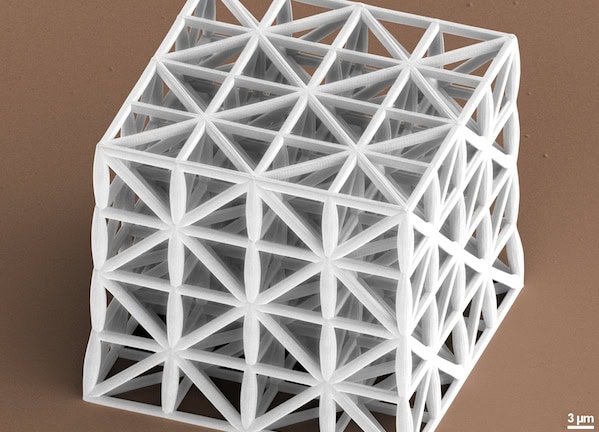
 Nanoscale microtruss structures built using 3D laser lithography mimic natural materials that are porous but strong. Credit: Bauer, KIT.
Nanoscale microtruss structures built using 3D laser lithography mimic natural materials that are porous but strong. Credit: Bauer, KIT.
How do you enhance the strength-to-weight ratio of a material? It seems that many scientists are looking to bone for inspiration.
CTT reported last week on a new method for making 3D porous materials from alumina-camphene slurries. In that report, a South Korean research group built porous materials that mimicked cancellous or trabecular bone (the porous and spongy interior part of bone) by composing arrayed structures of alumina with interconnected porosity and surrounding macrochannels.
A group at the Karlsruhe Institute of Technology in Germany now reports a different method, published in the latest issue of the Proceedings of the National Academies of Science, for building porous materials that mimic cancellous bone using 3D printing techniques. The authors used 3D direct laser writing, or 3D laser lithography, to fabricate nanoscale microstructures from alumina–polymer composites.
Lead author Jens Bauer described in an email the problems engineers face in building strong but lightweight materials, “The strength is often limited by defects—there are no solid materials that are significantly lighter than liquid water, but designing materials as cellular generally weakens them compared to bulk materials. We showed that applying microarchitecture can overcome those problems.”
Bauer explained that manmade cellular materials are weak because they are comprised of random structures (think foams). Natural materials are strong because they contain an organized hierarchy consisting of nanoscaled building blocks. “Because the size of the building blocks is that small, the material is much more flaw tolerant and therefore has a higher strength,” Bauer said in the email.
3D laser lithography uses a laser to precisely control local polymerization of a photoresist, providing the advantage of precise design flexibility and control. Translation? The sky’s (within reason) the limit when it comes to designing structures with 3D laser lithography. Watch this four-minute video from Nanoscribe, a leader of 3D laser lithographic technologies, to learn more about the technology.
The PNAS paper reported that the scientists created several different microstructure designs using 3D laser lithography to build polymer–ceramic composites (see example structure above). The shapes were created out of polymer substrates and then coated with aluminum oxide of varying thicknesses using atomic layer deposition. This process created beautifully intricate structures, which the team subsequently destroyed to test the structures’ strength (image below).
Microstructures exhibited failure at high compressive strengths, demonstrating the strength of these nanoscale designs. Credit: Bauer, KIT.
The microstructures stacked up—they exhibited compressive strengths “in the range of bone material and advanced metallic alloys,” the authors wrote.
They determined that the best structure was an optimized honeycomb design. These structures achieved specific strengths of up to 280 MPa, comparable to those of technical ceramics and high-strength steels and just shy of bulk alumina. Pretty impressive for a 3D printed microstructure!
The results represent an important proof of concept for 3D laser lithography, Bauer emailed. Although the technology cannot yet be scaled up to create larger structures, the new technology is quickly evolving. Once that is possible, “such materials could be applied everywhere where high strength and low density is needed at the same time (aerospace, aviation, motorsports, etc.), and also where the porosity is advantageous such as cushioning and filtration,” Bauer says.
The paper is titled “High-strength cellular ceramic composites with 3D microarchitecture.”
Author
April Gocha
CTT Categories
- Biomaterials & Medical
- Material Innovations
- Nanomaterials



